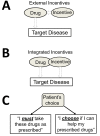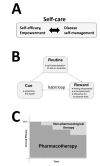Incorporating Natural Products, Pharmaceutical Drugs, Self-Care and Digital/Mobile Health Technologies into Molecular-Behavioral Combination Therapies for Chronic Diseases
- PMID: 27262323
- PMCID: PMC5011401
- DOI: 10.2174/1574884711666160603012237
Incorporating Natural Products, Pharmaceutical Drugs, Self-Care and Digital/Mobile Health Technologies into Molecular-Behavioral Combination Therapies for Chronic Diseases
Abstract
Merging pharmaceutical and digital (mobile health, mHealth) ingredients to create new therapies for chronic diseases offers unique opportunities for natural products such as omega-3 polyunsaturated fatty acids (n-3 PUFA), curcumin, resveratrol, theanine, or α-lipoic acid. These compounds, when combined with pharmaceutical drugs, show improved efficacy and safety in preclinical and clinical studies of epilepsy, neuropathic pain, osteoarthritis, depression, schizophrenia, diabetes and cancer. Their additional clinical benefits include reducing levels of TNFα and other inflammatory cytokines. We describe how pleiotropic natural products can be developed as bioactive incentives within the network pharmacology together with pharmaceutical drugs and self-care interventions. Since approximately 50% of chronically-ill patients do not take pharmaceutical drugs as prescribed, psychobehavioral incentives may appeal to patients at risk for medication non-adherence. For epilepsy, the incentive-based network therapy comprises anticonvulsant drugs, antiseizure natural products (n-3 PUFA, curcumin or/and resveratrol) coupled with disease-specific behavioral interventions delivered by mobile medical apps. The add-on combination of antiseizure natural products and mHealth supports patient empowerment and intrinsic motivation by having a choice in self-care behaviors. The incentivized therapies offer opportunities: (1) to improve clinical efficacy and safety of existing drugs, (2) to catalyze patient-centered, disease self-management and behavior-changing habits, also improving health-related quality-of-life after reaching remission, and (3) merging copyrighted mHealth software with natural products, thus establishing an intellectual property protection of medical treatments comprising the natural products existing in public domain and currently promoted as dietary supplements. Taken together, clinical research on synergies between existing drugs and pleiotropic natural products, and their integration with self-care, music and mHealth, expands precision/personalized medicine strategies for chronic diseases via pharmacological-behavioral combination therapies.
Figures





References
-
- Harrison C. Patenting natural products just got harder. Nat. Biotechnol. 2014;32(5):403–404. - PubMed
-
- Yates C.M., Calder P.C., Ed Rainger G. Pharmacology and therapeutics of omega-3 polyunsaturated fatty acids in chronic inflammatory disease. Pharmacol. Ther. 2014;141(3):272–282. - PubMed
-
- Oliveira A.S., Sousa E., Vasconcelos M.H., Pinto M. Curcumin: A Natural Lead for Potential New Drug Candidates. Curr. Med. Chem. 2015;22(36):4196–4232. - PubMed
Publication types
MeSH terms
Substances
LinkOut - more resources
Full Text Sources
Other Literature Sources
Medical

